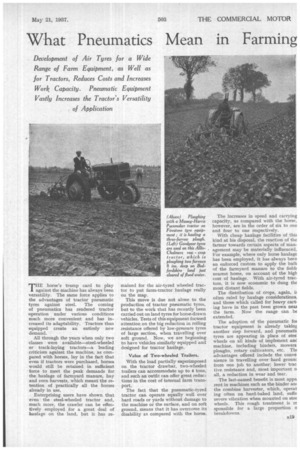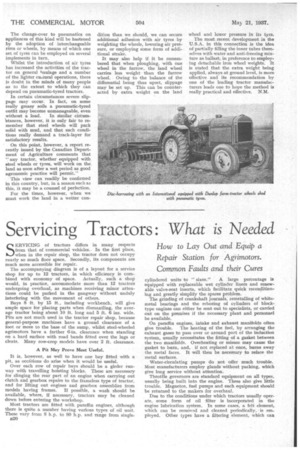What Pneumatics Mean in Farming
Page 53

Page 54

If you've noticed an error in this article please click here to report it so we can fix it.
THE horse's trump card to play against the machine has always been versatility. The same force applies to the advantages of tractor pneumatic tyres against steel. The coming of pneumatics has rendered tractor operation under various conditions much more convenient and has increased its adaptability. Tractors thus equipped create an entirely new demand.
All through the years when only two classes were available—steel-wheeled or track-laying tractors—a leading criticism against the machine, as compared with horses, lay in the fact that even if tractors were purchased, horses would still be retained in sufficient force to meet the peak demands for the haulage of farmyard manure, hay and corn harvests, which meant the re-. tention of practically all the horses already in use.
Enterprising users have shown that even the steel-wheeled tractor and, much more, the crawler can be effectively employed for a great deal of haulage on the land, but it has re mained for the air-tyred wheeled tractor to put farm-tractor haulage really on the map.
This move is due not alone to the production of tractor pneumatic tyres, but to the work that has recently been carried out on land tyres for horse-drawn vehicles. Tests of this equipment focused attention on the big reduction in rolling resistance offered by low-pressure tyres of large section, when travelling over soft ground. Now, we are beginning to have vehicles similarly equipped and designed for tractor haulage.
Value of Two-wheeted Trailers.
With the load partially superimposed on the tractor drawbar, two-wheeled trailers can accommodate up to 4 tons, and such an outfit can offer great reductions in the cost of internal farm transport.
The fact that the pneumatic-tyred tractor can operate equally well over hard roads or yards without damage to the machine or the surface, and on soft ground, means that it has overcome its disability as compared with the horse. The increases in speed and carrying capacity, as compared with the horse, however, are in the order of six to one and four to one respectively.
With cheap haulage facilities of this kind at his disposal, the reaction of the farmer towards certain aspects of management may be materially influenced. For example, where only horse haulage has been employed, it has always been an enforced custom to apply the bulk of the farmyard manure to the field: nearest home, on account of the high cost of haulage. With air-tyred tractors, it is now economic to dung the most distant fields.
The distribution of crops, again, it often ruled by haulage considerations, and those which called for heavy cart. lag have in the past been grown neat the farm. Now the range can be extended.
The adoption of the pneumatic fan tractor equipment is already takirq another step forward, and pneumatic t3rres are appearing in place of ste6 wheels on all kinds of implement ane machine, including binders, mowers ploughs, rotary cultivators, etc. Du advantages offered include the conve thence in travelling over hard groan( from one job to another; lower trac tive resistance and, most important o all, a reduction in wear and tear.
The last-named benefit is most appa rent in machines such as the binder an the combine harvester, which, operat ing often on hard-baked land, suffe severe vibration when mounted on stee wheels. This rough treatment is re sponsible for a large proportion o breakdowns. The change-over to pneumatics on appliances of this kind will be hastened by the adoption of interchangeable rims or wheels, by means of which one set of tyres can be employed on several implements in turn.
Whilst the introduction of air tyres has increased the activities of the tractor on general haulage and a number of the lighter cmeural operations, there is doubt in the minds of many people as to the extent to which they can depend on pneumatic-tyred tractors.
In certain circumstances severe slippage may occur. In fact, on some really greasy soils a pneumatic-tyred outfit may become unmanageable, even
without a load. In similar circum`1stances, however, it is only fair to remember that steel wheels will pack solid with mud, and that such conditions really demand a track-layer for satisfactory results.
On this point, however, a report recently issued by the Canadian Department of Agriculture comments that " any tractor, whether equipped with steel wheels or tyres, will work on the. land as soon after a wet period as good agronomic practice will permit."
This view can readily be confirmed in this country, but, in a season such as this, it may be a counsel of perfection.
For the times, however, when we must work the land in a wetter con
dition than we should, we can secure additional adhesion with air tyres by weighting the wheels, lowering air pressure, or employing sOme form of additional stroke.
It may also help if it be remembered that when ploughing, with one wheel in the furrow, the land wheel carries less weight than the furrow wheel. Owing to the balance of the differential being thus upset, slippage may be set up. This ran be counteracted by extra weight on the land wheel and lower pressure in its tyre.
The most recent development in the U.S.A. in this connection is the idea of partially filling the inner tubes themselves with water and anti-freezing mixture as ballast, in preference to employing detachable iron wheel weights. It is stated that the extra weight being applied, always at ground level, is more effective and its recommendation by one of the leading tractor manufacturers leads one to hope the method is really practical and effective. N.M.




































































































